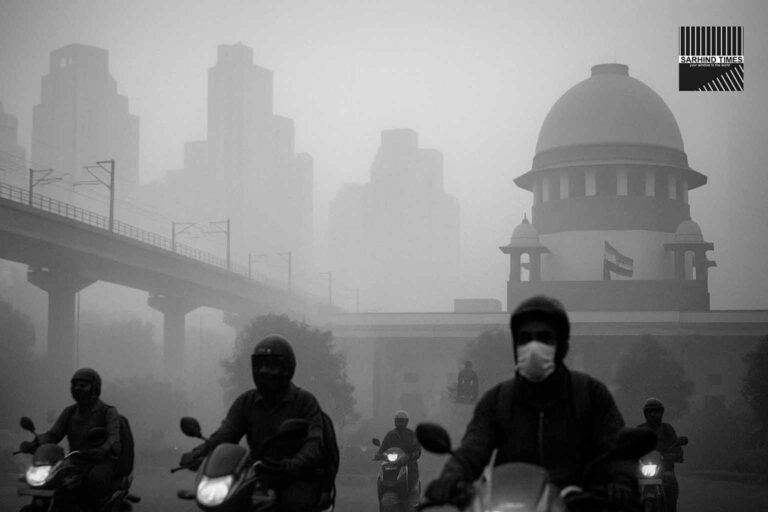A fresh Western Disturbance is set to rattle Delhi–NCR with heavy rain, thunderstorms, squally winds and a hail risk on Monday, followed by thunderstorms and strong surface winds on Tuesday. Monsoon withdrawal signs strengthen, with a temperature dip expected mid-week.
NEW DELHI/GURUGRAM | Monday, October 6, 2025
The India Meteorological Department (IMD) has placed the Haryana–Chandigarh–Delhi sub-division under a Day-1 warning for Heavy Rain, Thunderstorm & Lightning, Squall and Hailstorm on Monday, Oct 6, with a Day-2 warning for Tuesday, Oct 7 flagging Thunderstorm & Lightning and Strong Surface Winds. From Oct 8 onward, no sub-division warning is currently in force. The advisory is tied to a fresh Western Disturbance sweeping northwest India.
A separate IMD city bulletin for Delhi says a generally cloudy sky with light to moderate rain at many places, thunderstorm/lightning, and gusty winds 30–40 km/h—occasionally up to 50 km/h—on Oct 6, followed by one or two spells of rain with gusty 30–50 km/h winds during the morning/forenoon on Oct 7, turning partly cloudy thereafter. The same bulletin notes a fresh Western Disturbance arriving from Oct 6 and details the synoptic setup aloft.
Several outlets also summarised the colour-coded alert as yellow for the capital region, highlighting potential sharp temperature drop early this week as cool northwesterlies arrive behind the system.
The forecast at a glance
Today, Mon Oct 6 (Day-1):
- Delhi–NCR: Light to moderate rain at many places, thunderstorm/lightning, gusts 30–40 km/h (peaking ~50 km/h); Hailstorm risk for the wider Haryana–Chandigarh–Delhi sub-division.
- Why: Fresh Western Disturbance interacting with residual monsoon moisture; trough aloft in the upper-tropospheric westerlies.
Tue Oct 7 (Day-2):
- Morning/forenoon: One or two spells of light to moderate rain, thunderstorm/lightning, gusts 30–50 km/h, easing through the day; Strong Surface Winds flagged for the sub-division.
Wed Oct 8 onward:
- Partly cloudy → clear, no sub-division warning currently posted (Days 3–7). Temperatures likely to dip as northwesterlies set in after the disturbance exits and monsoon withdrawal progresses.
Why this spell matters
IMD’s Delhi bulletin ties today’s weather to a Western Disturbance (WD) seen as a cyclonic circulation over north Afghanistan & neighbourhood, with a trough aloft in the upper westerlies—classic October dynamics that deliver brief, intense convective bursts to northwest India. The bulletin explicitly flags gusty winds 30–40 km/h up to 50 km/h accompanying thunderstorms today and during the morning of Oct 7, before skies clear.
Simultaneously, the same document notes the line of monsoon withdrawal and says conditions are favourable for further withdrawal in 4–5 days, which climatologically opens the door for cooler northwesterlies—hence the expected temperature dip felt after Oct 7–8.
How it plays out across NCR (Delhi, Gurugram, Noida, Faridabad)
IMD’s zone-wise table for the capital and adjoining cities indicates similar hazards across West, South, Southwest, Southeast, Central and East Delhi, as well as Gurugram, Noida and Faridabad: generally cloudy, light–moderate rain at many places, thunderstorm/lightning, gusty winds 30–50 km/h today, with one or two spells on Tuesday morning and a clearing trend thereafter. For Gurugram specifically, the advisory mirrors Delhi’s, including the 30–50 km/h gust potential.
At the sub-division level, IMD’s Met Centre Chandigarh page explicitly lists for Haryana, Chandigarh & Delhi on Oct 6: Heavy Rain; Thunderstorm & Lightning; Squall; Hailstorm. On Oct 7, it lists Thunderstorm & Lightning; Squall; Strong Surface Winds; no warnings for Oct 8–12.
Potential impacts and advisories
Commuting & roads. Short, intense cells can reduce visibility and create waterlogging in minutes—especially at underpasses and low-lying stretches. Plan headway, slow earlier, and avoid sudden lane changes when road surfaces turn mirror-shiny (hydroplaning risk). With gusts up to ~50 km/h in thunderstorms, expect tree-branch fall and debris on outer ring-road segments and emerging expressway pockets during squalls.
Air & rail. Thunder clouds and gusts may force ground delays at IGI and slow-orders for Metro and suburban rail in exposed sections. Keep buffers and monitor operator bulletins.
Power & construction. Gusty winds can affect dangling cables, hoardings, and light scaffolding. Site managers should secure material, lower suspended loads, and pause crane operations during thunder activity.
Property & neighbourhoods. Secure outdoor objects (planters, signage, temporary gates), clear terrace drains, and check sump pumps if basement parking is prone to seepage. Keep torches/UPS charged in case of localised outages.
Health & schools. Rain improves AQI but spikes humidity; keep inhalers handy for asthmatics, and be cautious with seasonal flu. Schools and offices may consider staggered arrival during peak convective windows.
Motorists’ checklist (today–tomorrow): lights on, speed down; double following distance; avoid flooded underpasses; watch for hail alerts; never shelter under isolated trees during lightning; wait for squalls to pass before resuming travel.
Civic agencies in Delhi and Gurugram typically deploy pump sets and quick-response teams at habitual choke points during such warnings; residents are advised to report local flooding promptly via municipal helplines. (The Mausam portal remains the authoritative source for warning updates.)
The science in brief: what’s driving this spell
- Western Disturbance aloft: A cyclonic circulation in the upper troposphere with a trough axis near 7.6 km enhances lift; as it interacts with low-level moisture, thunderstorm cells fire over NCR.
- Squally winds: Downdraft outflows from convective cells translate into 30–40 km/h gusts, with peaks near 50 km/h in stronger storms—enough to rattle scaffolds and topple light hoardings.
- Hail risk: The sub-division page lists “Hailstorm” in today’s hazards; brief hail cores are possible where updrafts are strongest.
- Monsoon withdrawal: IMD notes continued withdrawal line and favourable conditions for further retreat over the next 4–5 days, a typical prelude to cooler, drier northwesterlies and a temperature dip after the WD exits.
Today vs. normal: where temperatures stand
IMD’s Delhi bulletin records minimums 23–24°C and maximums 32–34°C in the last 24 hours; minimums were 1–2°C above normal while maximums were near normal. As the WD clears and northwesterlies intrude mid-week, the daytime high should slip and mornings may feel decidedly cooler for early October.
City by city: how to read the warning
- Delhi (all zones):
Expect multiple showers, thunder, and gusts 30–50 km/h today; a Tuesday morning spell before clearing. Watch underpasses (ITO, Minto Bridge), outer ring-road low spots, and construction corridors. - Gurugram:
IMD lists the same hazards as Delhi; watch for brief squalls around Cyber City – NH-48 corridors and Sohna Road. Plan extra commute time and avoid flooded service-lane pockets during peak traffic. - Noida & Faridabad:
Similar risk envelope. Avoid low-lying underpasses; golf-course and expressway stretches can see cross-winds during thunder outflows.
What the colour means (and doesn’t)
Numerous media reports shorthand today’s advisory as a “yellow alert” for Delhi and NCR. Colour codes help communicate urgency, but the actual hazard list—what IMD writes in black and white—matters more for action: Heavy Rain; Thunderstorm/Lightning; Squall; Hailstorm (Oct 6), and Thunderstorm/Lightning; Squall; Strong Surface Winds (Oct 7) for the Haryana–Chandigarh–Delhi sub-division. Keep an eye on the Mausam page for any real-time updates.
After the rain: the mid-week picture
IMD’s All-India Weather bulletin, issued Sunday evening, flagged the fresh WD entering on Oct 6; by mid-week the system decays eastward and northwesterlies gain ground over the plains. That pattern typically clears skies, drops humidity, and nudges temperatures lower—a pre-winter feel that Delhiites recognise from previous Octobers.
Practical guide for residents and commuters (Oct 6–7)
Home & society:
- Clear terrace and balcony drains; secure loose planters/signage.
- Park away from trees and basements prone to seepage.
- Keep flashlights charged; unplug sensitive devices during lightning.
On the road:
- Lights on; speed down; keep two-car gaps.
- Avoid waterlogged underpasses; do not drive through fast-moving water.
- If hail or severe squall hits, pull over safely; wait 10–15 minutes.
Work & school:
- Allow buffer time; consider staggered entry.
- Shift outdoor tasks to mid-day gaps; pause crane/high-mast work during gusts.
Pet & outdoor care:
- Bring pets inside during thunder; avoid open fields and terraces in lightning.
Information hygiene:
- Trust official IMD bulletins and your city’s disaster management handles; ignore unverified WhatsApp “alerts.”
#IMDAlert #DelhiNCR #Gurgaon #Weather #Thunderstorms #Hail #TrafficAlert #Rain

























+ There are no comments
Add yours